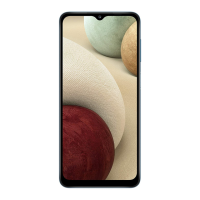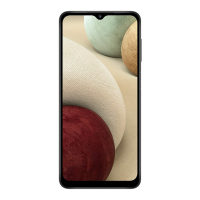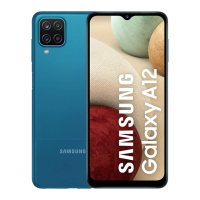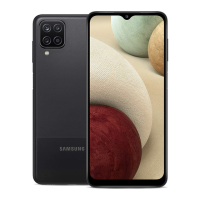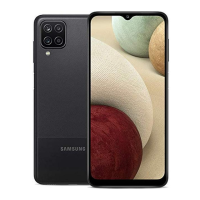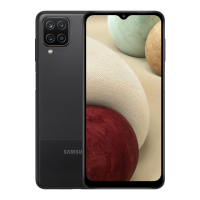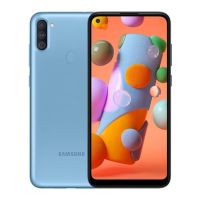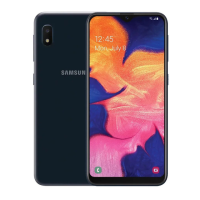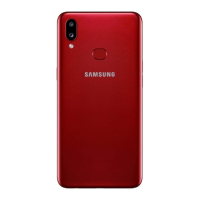Do you have a question about the Samsung SM-A125M and is the answer not in the manual?
Essential safety and usage guidelines before operating the device.
Solutions for when the device becomes hot during the charging process.
Explains common scenarios leading to device overheating during operation.
Lists items included in the device package and accessory compatibility.
Illustrates physical components and their locations on the device.
Details the function and operation of physical keys on the device.
Describes the on-screen navigation buttons and their uses.
Step-by-step guide for charging the device using a wired connection.
Explains how to use fast charging and conserve battery power.
Important advice and warnings related to charging the device's battery.
Guide on how to insert the SIM or USIM card into the device tray.
Instructions for inserting a microSD card for expanded storage.
Procedures for safely removing and formatting memory cards.
Steps for powering the device on, off, and performing a forced restart.
Guide to emergency mode and the initial device setup process.
Steps for creating and signing into a Samsung account.
Details on finding IDs, resetting passwords, and signing out of Samsung accounts.
Instructions for transferring data from an old device to the new one.
Explains various touch gestures for interacting with the device screen.
Details on the function of the on-screen navigation buttons.
How to switch between and manage the device's Home and Apps screens.
Options for changing wallpapers, themes, widgets, and screen layout.
Using Finder for search and organizing apps into folders.
How to set up screen lock types like pattern, PIN, or biometrics.
Explains common icons displayed on the device's status bar.
Method for taking screenshots of the device screen.
How to access and use the notification panel and quick settings.
Guide to activating features using the quick setting buttons.
Explains the on-screen keyboard layout and how to enter text.
Procedures for switching input languages and keyboard types.
Additional keyboard features like emoticons, GIFs, voice input, and text editing.
How to select, copy, cut, and paste text on the device.
Steps for downloading, installing, and removing apps from the device.
Instructions for initiating and receiving calls on the device.
Covers making calls from logs, speed dial, and handling incoming calls.
Creating, importing, and syncing contacts with web accounts.
Methods for finding, organizing, and sharing contact information.
How to compose, send, and view SMS/MMS messages.
Using the internet browser and its secret mode feature.
Introduction to the camera app and guidelines for responsible photography.
Instructions on capturing photos and utilizing various camera shooting modes.
How to use zoom, camera button functions, and adjust shooting options.
Using photo mode, taking selfies, and applying visual effects.
Recording videos and using the live focus feature for portrait effects.
Manual controls for exposure, ISO, and white balance in Pro mode.
Using panorama, food, and macro modes for specific photo types.
Viewing, organizing, and managing photos and videos.
Methods for viewing images and cropping enlarged photos.
Playing videos and organizing media into albums.
Creating stories, deleting files, and managing the recycle bin.
Running two apps simultaneously using split screen or pop-up view.
Creating, editing, and deleting notes using the Samsung Notes app.
Using Samsung Members and managing calendar events.
Setting up and managing to-do list reminders.
How to use the FM radio app, scan stations, and play through the speaker.
Using the voice recorder and managing files with My Files.
Utilizing the clock for alarms and the calculator for computations.
Organizing games and adjusting performance modes for gaming.
Using Game Booster to optimize gaming environment and features.
Methods for sharing content with nearby devices using Quick Share.
Creating shared albums and learning about Samsung Global Goals.
Brief descriptions of Google apps like Chrome, Gmail, Maps, etc.
Introduction to accessing and searching within the device settings.
Configuring Wi-Fi and Bluetooth settings for network access.
Steps for connecting to available Wi-Fi networks.
How to establish direct device-to-device connections using Wi-Fi Direct.
Process for pairing the device with other Bluetooth-enabled devices.
Sharing files and data using Bluetooth technology.
Activating data saver to reduce mobile data consumption.
Selecting apps to use mobile data even when connected to Wi-Fi.
Turning the device into a Wi-Fi hotspot to share internet connection.
Customizing settings for nearby devices, VPNs, and private DNS.
Setting up printer plug-ins and printing documents or images.
Configuring ringtones, notification sounds, volume, and vibration patterns.
Enhancing audio experience with Dolby Atmos and equalizer settings.
Customizing how notifications are displayed and managed.
Adjusting screen brightness and enabling dark mode for comfort.
Customizing text size, screen zoom, and display timeout duration.
Modifying the home screen layout and navigation bar behavior.
Changing the device's visual appearance with themes.
Setting screen lock types, clock styles, and notifications on the lock screen.
Setting up trusted locations or devices for automatic screen unlocking.
Configuring face recognition, fingerprint, Google Play Protect, and security updates.
Guidelines for effective and secure face recognition setup.
Steps for registering your face and enabling face unlock.
How to remove or modify registered facial data.
Tips for optimal fingerprint scanning performance and security.
Process for registering fingerprints and using them for screen unlock.
How to remove previously registered fingerprint data.
Managing app permissions and diagnostic data sharing with Samsung.
Controlling marketing communications and Samsung account privacy.
Configuring location settings and managing app location access.
Managing accounts, backing up data, and using Samsung Cloud.
Detailed procedures for managing data with Samsung Cloud.
Configuring settings for Google services integrated with the device.
Introduction to features like Side Key, Smart Pop-up View, and Screenshots.
Utilizing device movements and gestures for various functions.
Using two instances of a messenger app for different accounts.
Steps to remove a second instance of a messenger app.
Managing device usage time and setting parental controls.
Using Device Care to improve device speed and efficiency.
Monitoring battery usage and activating power saving modes.
Checking device storage, memory, and security status.
Reducing mobile data usage with data compression and background app restrictions.
Viewing app usage, permissions, and uninstalling/disabling apps.
Customizing system settings, language, date/time, and performing resets.
Adjusting settings to improve device accessibility for various users.
Information on updating device software and security patches.
Viewing device name, status, legal, software, and battery information.
How to find the device's unique IMEI number.
Solutions for password, PIN, PUK, and PIN2 prompts.
Addressing issues with weak signals, reception loss, and service errors.
Steps to take if the device fails to turn on, typically due to battery.
Solutions for slow or improper touchscreen operation.
Procedures for restarting and forcing a restart when the device freezes.
Steps to resolve issues with not being able to connect calls.
Solutions for others not hearing you or sound echoes during calls.
Addressing intermittent network loss and poor audio quality.
Solutions for battery not charging properly or depleting faster than usual.
Troubleshooting camera app errors and poor photo quality.
Resolving issues with opening or playing multimedia files.
Solutions for Bluetooth pairing and connection problems.
Fixing issues with the brightness bar and device-to-computer connections.
Troubleshooting GPS signal obstruction and location finding issues.
Importance of backups, managing storage space, and home button visibility.
Information on device compatibility with hearing aids for newer technologies.
Explanation of FCC regulations regarding hearing aid compatibility.
Essential safety and usage guidelines before operating the device.
Solutions for when the device becomes hot during the charging process.
Explains common scenarios leading to device overheating during operation.
Lists items included in the device package and accessory compatibility.
Illustrates physical components and their locations on the device.
Details the function and operation of physical keys on the device.
Describes the on-screen navigation buttons and their uses.
Step-by-step guide for charging the device using a wired connection.
Explains how to use fast charging and conserve battery power.
Important advice and warnings related to charging the device's battery.
Guide on how to insert the SIM or USIM card into the device tray.
Instructions for inserting a microSD card for expanded storage.
Procedures for safely removing and formatting memory cards.
Steps for powering the device on, off, and performing a forced restart.
Guide to emergency mode and the initial device setup process.
Steps for creating and signing into a Samsung account.
Details on finding IDs, resetting passwords, and signing out of Samsung accounts.
Instructions for transferring data from an old device to the new one.
Explains various touch gestures for interacting with the device screen.
Details on the function of the on-screen navigation buttons.
How to switch between and manage the device's Home and Apps screens.
Options for changing wallpapers, themes, widgets, and screen layout.
Using Finder for search and organizing apps into folders.
How to set up screen lock types like pattern, PIN, or biometrics.
Explains common icons displayed on the device's status bar.
Method for taking screenshots of the device screen.
How to access and use the notification panel and quick settings.
Guide to activating features using the quick setting buttons.
Explains the on-screen keyboard layout and how to enter text.
Procedures for switching input languages and keyboard types.
Additional keyboard features like emoticons, GIFs, voice input, and text editing.
How to select, copy, cut, and paste text on the device.
Steps for downloading, installing, and removing apps from the device.
Instructions for initiating and receiving calls on the device.
Covers making calls from logs, speed dial, and handling incoming calls.
Creating, importing, and syncing contacts with web accounts.
Methods for finding, organizing, and sharing contact information.
How to compose, send, and view SMS/MMS messages.
Using the internet browser and its secret mode feature.
Introduction to the camera app and guidelines for responsible photography.
Instructions on capturing photos and utilizing various camera shooting modes.
How to use zoom, camera button functions, and adjust shooting options.
Using photo mode, taking selfies, and applying visual effects.
Recording videos and using the live focus feature for portrait effects.
Manual controls for exposure, ISO, and white balance in Pro mode.
Using panorama, food, and macro modes for specific photo types.
Viewing, organizing, and managing photos and videos.
Methods for viewing images and cropping enlarged photos.
Playing videos and organizing media into albums.
Creating stories, deleting files, and managing the recycle bin.
Running two apps simultaneously using split screen or pop-up view.
Creating, editing, and deleting notes using the Samsung Notes app.
Using Samsung Members and managing calendar events.
Setting up and managing to-do list reminders.
How to use the FM radio app, scan stations, and play through the speaker.
Using the voice recorder and managing files with My Files.
Utilizing the clock for alarms and the calculator for computations.
Organizing games and adjusting performance modes for gaming.
Using Game Booster to optimize gaming environment and features.
Methods for sharing content with nearby devices using Quick Share.
Creating shared albums and learning about Samsung Global Goals.
Brief descriptions of Google apps like Chrome, Gmail, Maps, etc.
Introduction to accessing and searching within the device settings.
Configuring Wi-Fi and Bluetooth settings for network access.
Steps for connecting to available Wi-Fi networks.
How to establish direct device-to-device connections using Wi-Fi Direct.
Process for pairing the device with other Bluetooth-enabled devices.
Sharing files and data using Bluetooth technology.
Activating data saver to reduce mobile data consumption.
Selecting apps to use mobile data even when connected to Wi-Fi.
Turning the device into a Wi-Fi hotspot to share internet connection.
Customizing settings for nearby devices, VPNs, and private DNS.
Setting up printer plug-ins and printing documents or images.
Configuring ringtones, notification sounds, volume, and vibration patterns.
Enhancing audio experience with Dolby Atmos and equalizer settings.
Customizing how notifications are displayed and managed.
Adjusting screen brightness and enabling dark mode for comfort.
Customizing text size, screen zoom, and display timeout duration.
Modifying the home screen layout and navigation bar behavior.
Changing the device's visual appearance with themes.
Setting screen lock types, clock styles, and notifications on the lock screen.
Setting up trusted locations or devices for automatic screen unlocking.
Configuring face recognition, fingerprint, Google Play Protect, and security updates.
Guidelines for effective and secure face recognition setup.
Steps for registering your face and enabling face unlock.
How to remove or modify registered facial data.
Tips for optimal fingerprint scanning performance and security.
Process for registering fingerprints and using them for screen unlock.
How to remove previously registered fingerprint data.
Managing app permissions and diagnostic data sharing with Samsung.
Controlling marketing communications and Samsung account privacy.
Configuring location settings and managing app location access.
Managing accounts, backing up data, and using Samsung Cloud.
Detailed procedures for managing data with Samsung Cloud.
Configuring settings for Google services integrated with the device.
Introduction to features like Side Key, Smart Pop-up View, and Screenshots.
Utilizing device movements and gestures for various functions.
Using two instances of a messenger app for different accounts.
Steps to remove a second instance of a messenger app.
Managing device usage time and setting parental controls.
Using Device Care to improve device speed and efficiency.
Monitoring battery usage and activating power saving modes.
Checking device storage, memory, and security status.
Reducing mobile data usage with data compression and background app restrictions.
Viewing app usage, permissions, and uninstalling/disabling apps.
Customizing system settings, language, date/time, and performing resets.
Adjusting settings to improve device accessibility for various users.
Information on updating device software and security patches.
Viewing device name, status, legal, software, and battery information.
How to find the device's unique IMEI number.
Solutions for password, PIN, PUK, and PIN2 prompts.
Addressing issues with weak signals, reception loss, and service errors.
Steps to take if the device fails to turn on, typically due to battery.
Solutions for slow or improper touchscreen operation.
Procedures for restarting and forcing a restart when the device freezes.
Steps to resolve issues with not being able to connect calls.
Solutions for others not hearing you or sound echoes during calls.
Addressing intermittent network loss and poor audio quality.
Solutions for battery not charging properly or depleting faster than usual.
Troubleshooting camera app errors and poor photo quality.
Resolving issues with opening or playing multimedia files.
Solutions for Bluetooth pairing and connection problems.
Fixing issues with the brightness bar and device-to-computer connections.
Troubleshooting GPS signal obstruction and location finding issues.
Importance of backups, managing storage space, and home button visibility.
Information on device compatibility with hearing aids for newer technologies.
Explanation of FCC regulations regarding hearing aid compatibility.
| Model | SM-A125M |
|---|---|
| Resolution | 720 x 1600 pixels |
| RAM | 4 GB |
| Storage | 64 GB |
| Front Camera | 8 MP |
| Battery | 5000 mAh |
| Colors | Black, White, Blue, Red |
| Display | 6.5 inches |
| Processor | MediaTek Helio P35 |
| Operating System | Android 11 |
| SIM | Dual SIM (Nano-SIM, dual stand-by) |
| Dimensions | 164 x 75.8 x 8.9 mm |
